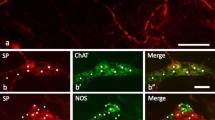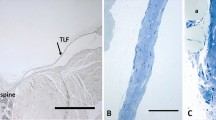Summary
The sternomastoid muscle of the rat is divided into a white (dominated by fast-glycolytic twitch fibers) and a red (dominated by fast oxidative-glycolytic twitch fibers, but also containing slow-oxidative twitch fibers) compartent. Previous reports on exclusive location of muscle spindles in the red portion were confirmed. On the basis of anterograde labeling with horseradish peroxidase-wheat germ agglutinine conjugate (WGA-HRP) it was shown in this study that, in addition to muscle spindle compartmentalisation, there was also an exclusive occurrence of tendon organs in the red part of the muscle; moreover, fine afferents (III- and IV-afferents) were mainly distributed to this portion as well.
Radioimmunassay studies revealed that this part of the muscle contained twice as much substance P as the white part.
It could be shown by acetylcholinesterase (AChE) histochemistry that the myelinated fibers of the white branch to the muscle exclusively displayed high enzyme activity which is characteristic for motor fibers; on the other hand, in the branch to the red portion two classes of AChE-positive fibers were found: a large one with a peak in the alpha-range, and a small one with a peak in the gammarange. In addition, there was also a group of enzyme-negative (sensory) fibers. These results also indicate the red portion of the sternomastoid muscle to be its “sensory compartment”.
Similar content being viewed by others
References
Aldskogius H, Kinnman E, Persson J (1986) Labeling of cutaneous sensory nerve endings with axonally transported horseradish peroxidase and wheat germ Agglutinin-horseradish peroxidase conjugate: a methodological study in the rat. J Neurosci Meth 15:281–294
Andres KH, von Düring M, Schmidt RF (1985) Sensory innervation of the Achilles tendon by group III and IV afferent fibers. Anat Embryol 172:145–156
Binder MD (1985) Changing perspectives on the functional organization of the segmental motor system. Can J Phyiol Pharmacol 64:495–498
Botterman BR, Binder MB, Stuart DG (1978) Functional Anatomy of the association between motor units and muscle receptors. Am Zool 18:135–152
Brichta AM, Callister RJ, Peterson EH (1987) Quantitative analysis of cervical musculature in rats: Histochemical composition and motor pool organization. J Comp Neurol 255:351–368
Dulhunty AF, Dlutowski M (1979) Fiber types in red and white segments of rat sternomastoid muscle. Am J Anat 156:51–62
Gamse R, Holzer P, Lembeck F (1980) Decrease of substance P in primary afferent neurons and impairment of neurogenic plasma extravasation by capsaicin. Br J Pharmacol 68:207–213
Gonyea WJ, Ericson GC (1977) Morphology and histochemical organization of the flexor carpi radialis muscle in the cat. Am J Anat 148:329–344
Gottschall J, Zenker W, Neuhuber W, Mysicka W, Müntener M (1980) The sternomastoid muscle of the rat and its innervation. Muscle fiber composition, perikarya and axons of efferent and afferent neurons. Anat Embryol 160:285–300
Grim M (1972) On the problem of irregular distribution of muscle spindles. Folia Morphol 20:119–120
Gruber H, Zenker W (1973) Acetylcholinesterase: histochemical differentiation between motor and sensory fibers. Brain Res 51:207–214
Gundersen K, Oktedalen O, Fonnum F (1985) Substance P in subdivisions of the sciatic nerve, and in red and white muscles. Brain Res 329:97–103
Henneman E, Olsen CB (1965) Relations between structure and function in the design of skeletal muscles. J Neurophysiol 289:581–598
Hinsey JC (1927) Some observations on the innervation of skeletal muscle of the cat. J Comp Neurol 44:87–195
Horcholle-Bossavit G, Jami L, Petit J, Vejsada R, Zytnicki D (1986) Encoding of muscle force by Golgi tendon organs. Advances in Muscular Proprioception. Local Satellite Symposion of the 10th Annual Meeting of the Eur Neurosci Assoc. Hulliger H, Roll JP, Vedel JP (eds) Book of Abstracts, p 14, Marseille
Illing RB, Wässle H (1979) Visualization of the HRP reaction product using the polarization microscope. Neurosci Lett 13:7–11
Karnovsky MJ, Roots L (1964) A direct coloring thiocholine method for cholinesterases. J Histochem Cytochem 12:219–221
Luff AR (1985) Dynamic properties of fiber bundles from the rat sternomastoid muscle. Exp Neurol 89:491–502
Maier A (1979) Occurrence and distribution of muscle spindles in masticatory and suprahyoid muscles of the rat. Am J Anat 155:483–506
Maier A, Simpson DR, Edgerton VR (1976) Histological and histochemical comparisons of muscle spindles in three hind limb muscle of the guinea pig. J Morphol 148:185–192
McMahon SB, Sykova E, Wall PD, Woolf CJ, Gibson SJ (1984) Neurogenic extravasation and substance P levels are low in muscle as compared to skin in the rat hind limb. Neurosci Lett 52:235–240
Mesulam MM (1978) Tetramethyl benzidine for horseradish peroxidase neurohistochemistry: a non-carcinogenic blue reaction product with superior sensitivity for visualizing neural afferents and efferents. J Histochem Cytochem 26:106–117
Richmond FJR, Abrahams VC (1975) Morphology and distribution of muscle spindles in dorsal muscles of the cat neck. J Neurophyisol 38:1322–1339
Richmond FJR, Stuart DG (1985) Distribution of sensory receptors in the flexor carpi radialis muscle of the cat. J Morphol 183:1–13
Robertson B, Aldskogius H (1982) The use of anterogradely transported wheat germ agglutinin-horseradish peroxidase conjugate to visualize cutaneous sensory nerve endings. Brain Res 240:327–330
Sandoz PA, Zenker W (1986) Unmyelinated axons in a muscle nerve. Electronmicrosopic morphometry of the sternomastoid nerve in normal and sympathectomized rats. Anat Embryol 174:207–213
Siegel S (1956) Nonparametric statistics for the behavioral sciences. Mc Graw Hill, New York, p 330
Stacey MJ (1969) Free nerve endings in skeletal muscle of the cat. J Anat 105:231–254
Streinzer W, Krammer EB (1986) Horseradish peroxidase histochemistry on mounted sections from embedded specimen: a simple method for serial reconstruction of neuronal projections. J Neurosci Meth 17:297–301
Yellin H (1969) A histochemical study of muscle spindles and their relationship to extrafusal fiber types in the rat. Am J Anat 125:31–45
Zenker W, Hohberg E (1973) Alphamotorische Nervenfasern, Axonquerschnittsfläche von Stammfaser und Endästen. Z Anat Entw Gesch 139:163–172
Author information
Authors and Affiliations
Additional information
Dedicated to Prof. T.H. Schiebler on the occasion of his 65th birthday
Rights and permissions
About this article
Cite this article
Zenker, W., Sandoz, P.A. & Neuhuber, W. The distribution of anterogradely labeled I–IV primary afferents in histochemically defined compartments of the rat's sternomastoid muscle. Anat Embryol 177, 235–243 (1988). https://doi.org/10.1007/BF00321134
Accepted:
Issue Date:
DOI: https://doi.org/10.1007/BF00321134




